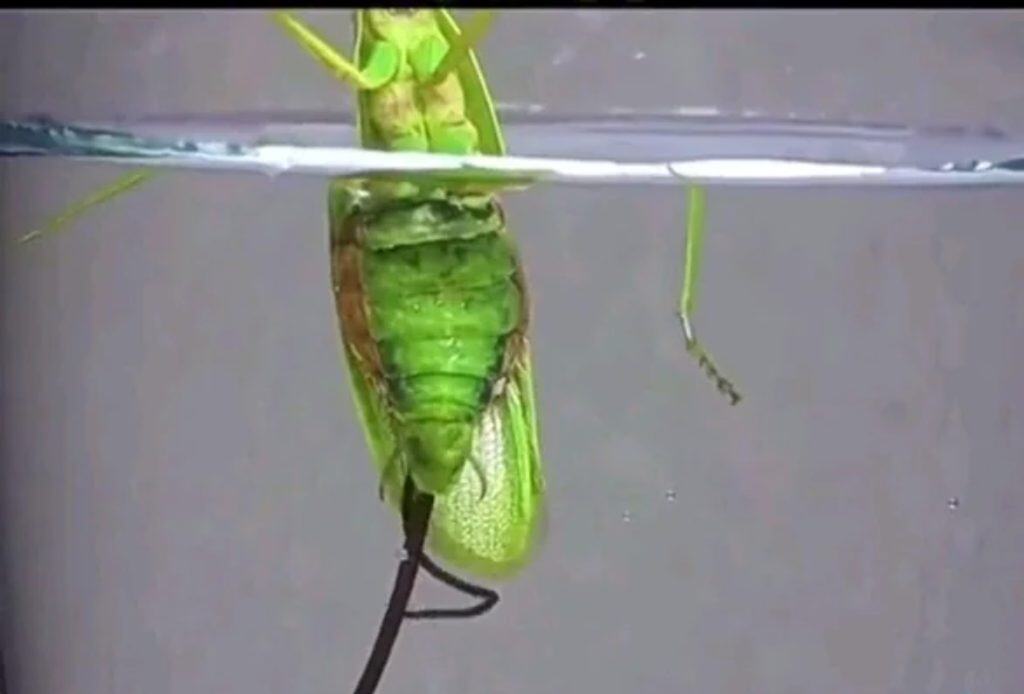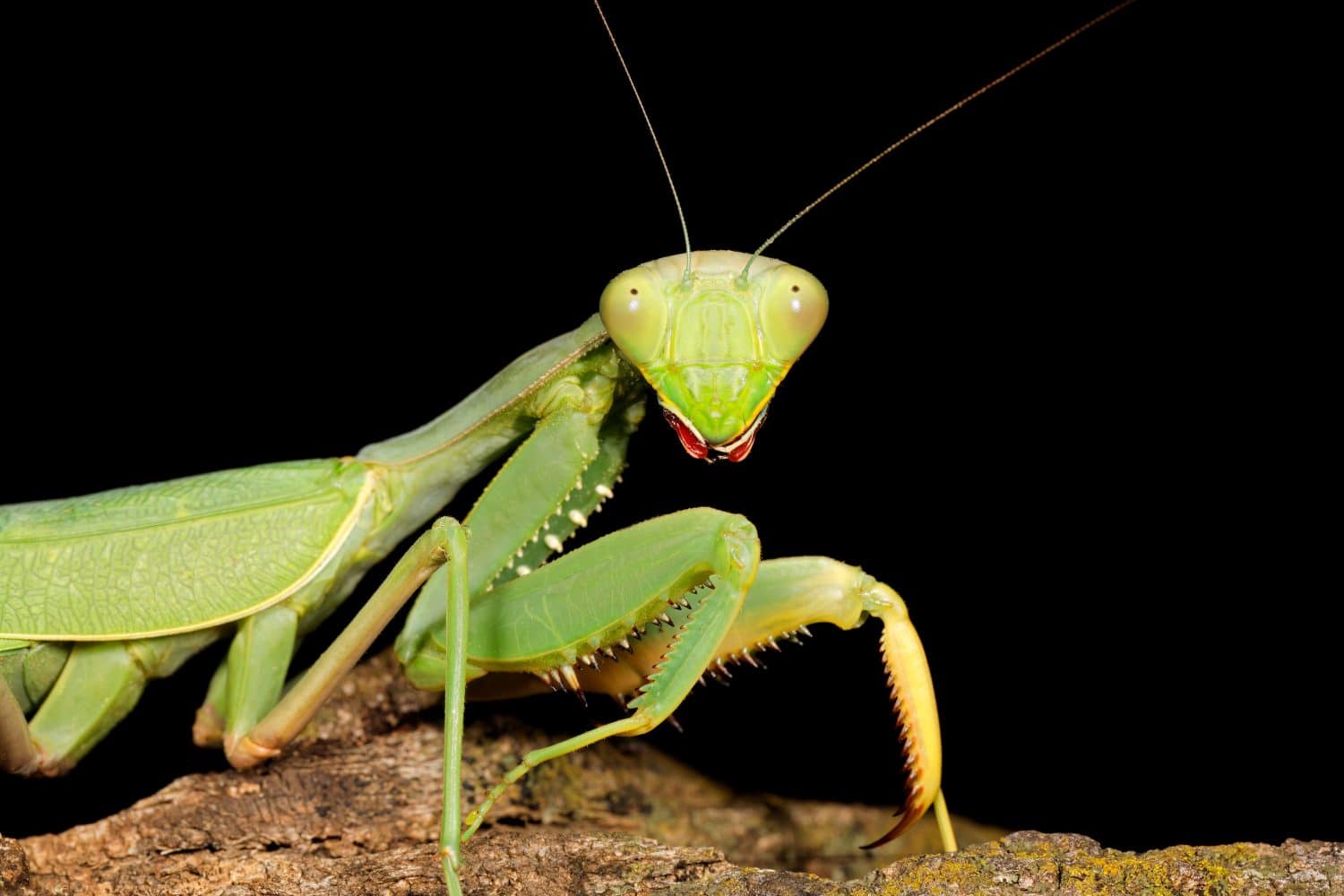
The post The Deadly Parasite That Forces Praying Mantises to Drown appeared first on A-Z Animals.
Praying mantises are seen as the apex predators of the insect world. Because of this, they are seen as formidable foes to those who encounter them. However, even the strongest praying mantis is not immune to parasitic infection. Consequently, the more aquatic insects they consume, the higher the chances of infection.
Aquatic insects feast on the larvae of horsehair worms. Once these larvae are eaten, they are just waiting for a host like the praying mantis to eat the insect that ate them. After the insect is consumed, the horsehair worm wastes no time in infecting the mantis. Therefore, when signs of an infection are present, those who own praying mantises need to know how to force a parasite out of the mantis.
How to Remove a Parasite From a Praying Mantis

Horsehair worms are expelled from praying mantises when their rear ends are put in water.
© – Original
A YouTube video showing a horsehair worm leaving a praying mantis has gone viral in just a matter of months, with over 99 million views. This video shows just how infectious a horsehair worm can be to a mantis if left to mature in its body.
The video shows the praying mantis’ rear being placed in water as it is carefully held with a pair of tweezers. If this were done in the wild, as the caption to the video states, the worm would have caused the mantis to drown in order to remove itself.
As the praying mantis is placed in water, a massive parasitic horsehair worm emerges from its backside. These worms will spend weeks to months in the body of the mantis as they mature. If left to reach maturity, the worms will cause so much internal damage to the mantises that even if not led to drown themselves, the chances of survival are slim.
This is why it is important for those who have captive praying mantises to pay attention to their pets, as the sooner the horsehair worm is removed from the mantis, the better the chances are that the mantis will survive maturity and live out its months of life versus having it cut short by the horsehair worm.
The Power of Water

The horsehair worm wants to be in an aquatic environment, which is why placing the rear of the mantis in the water expels them.
©JoergHoffmann/Shutterstock.com
If a praying mantis is believed to be infected with a horsehair worm, placing the backside of the mantis in water is an effective way of removing the worm, as the aquatic environment is where the worm would like to be. Horsehair worms grow from small parasites to massive worms in a matter of weeks to months. While this is happening, the mantis is slowly dying as the worm destroys the internal structure of the mantis’ body.
In general, the horsehair worm will not expel itself from the mantis’ body until it is mature. However, if the mantis’ rear is placed in water, the horsehair worm may leave its host before it grows too long. The worm may be tricked into thinking it is ready to reproduce and leave the mantis’ body before too much damage has been done to the praying mantis, allowing it to live out its life, rather than it being cut short. It is not clear if the worm leaving the mantis’ body is painful or not. However, the alternative of leaving the worm in the body is death. Consequently, the lesser of the two evils is removing the horsehair worm as soon as it is detected.
Horsehair Worms Cause Praying Mantises to Drown

Horsehair worms will force mantises to go to bodies of water to drown themselves so the worms can escape the body.
©Tomasz Grygorowicz/Shutterstock.com
Horsehair worms, as seen in the YouTube video, are such an invasive parasite to the praying mantis that the worms actually cause the insect to drown itself. According to a 2023 study published in Current Biology, horsehair worms use the proteins in praying mantis bodies to essentially hijack the nerve systems of the mantis. This allows the horsehair worm to control what the mantis does.
When the horsehair worm is ready to be expelled from the mantis, it will force the mantis to a body of water, so that the horsehair worm can wiggle free. This can only be accomplished by the praying mantis drowning itself. Once the horsehair worm is free in the water, it will reproduce and lay eggs, ending its life cycle as another one begins.
An Infected Praying Mantis May Not Survive

A praying mantis may not survive after a horsehair worm infection.
©Noppe Herlinde/Shutterstock.com
Unfortunately, after a horsehair worm infects a praying mantis, the likelihood of survival is not great. If the mantis does not drown itself, then the damage that has been done internally may be too much for the mantis to overcome. In the wild, once a horsehair worm infects a praying mantis, it spells a death sentence for the mantis. This has to do with the worm taking over the nerve systems once it matures, leaving the mantis helpless against drowning itself, so that the horsehair worm can survive. However, if a captive mantis is discovered early on to have a horsehair worm, there may not be too much internal damage done. If this is the case, it is entirely possible that the mantis can live out its full four to six months of life.
Additionally, male praying mantises are more often infected than females. It is not known why this happens, but it has been suggested that horsehair worms are drawn to male mantis hormones versus female. Females have been proven to have a better chance of survival if infected and can even go on to reproduce, with those organs not being affected by the parasitic worm. Males, on the other hand, will lose their reproductive organs if the worms are allowed to reach maturity. This is believed to happen as the male mantises do not need their gonads to survive, allowing the horsehair worms to pull energy from the mantis’ body without killing it before the horsehair worm matures.
How Horsehair Worms Infect Praying Mantises

Horsehair worms infect praying mantises after the mantises eat an insect that has consumed the horsehair worm larvae.
©WildMedia/Shutterstock.com
Horsehair worms do not start off as worms when they infect praying mantises. In fact, they do not even infect the insects themselves. It is a result of the mantises eating an aquatic insect that starts the process of being infected. Small aquatic insects will eat horsehair worm larvae. The larvae do not impact the aquatic insect. Instead, it waits until the mantis consumes the aquatic insect to begin its transition from larvae to worm.
After the praying mantis eats the insect, the larvae will begin to grow inside the mantis. The larvae will take weeks to months to grow to their mature size. To do this, the worm will consume the nutrients the mantis is taking in to grow. This will cause the mantis to have stunted growth and other health problems, which are tell-tale signs of a praying mantis being infected by a horsehair worm.
How to Tell If a Praying Mantis Is Infected With a Parasite

Praying mantises will have behavior changes when infected by a horsehair worm.
©EcoPrint/Shutterstock.com
Praying mantises, not being able to communicate, have been infected with a parasite. Those who have mantises as pets will need to pay close attention to the way the insects act to determine if their behavior is off. While many mantises kept as pets will not be infected with horsehair worms, it is possible that before coming into captivity, an infection occurred.
Signs of horsehair worm infection include:
- Strange behavior, including erratic movements
- Deformities including stunted growth, lack of wings, or discoloration
- Suddenly increased abdomen
- Lethargy or decreasing activity levels
- Seeing the horsehair worm attempt to remove itself from the mantis’ backside
If any of this is present, it is likely that a horsehair worm has infected the praying mantis. If not comfortable with placing the praying mantis’ rear in water, it is recommended to speak to a professional to get a diagnosis and the necessary treatment to save the praying mantis before the horsehair worm has done too much irreparable damage, and recovery is impossible for the mantis.
The post The Deadly Parasite That Forces Praying Mantises to Drown appeared first on A-Z Animals.
August 14, 2025 at 06:02PMJessica Tucker
.jpeg)
.jpeg)

0 Comments